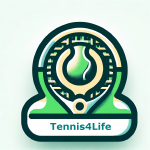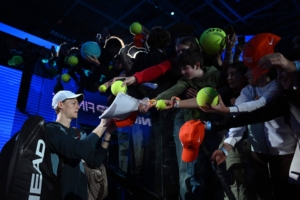The Stats Don’t Lie: Why the First Set Is Critical
/in News, Singles, WhispererThe Stats on Losing Set 1:
-
Low Recovery Rates After Losing Set 1: Players who drop the first set in a singles match generally have less than a 25% chance of winning the match in three sets.
-
Exceptional Comeback Rates Among Top Pros: Elite players like Djokovic and Federer boast recovery rates exceeding 40%, highlighting their superior mental toughness and strategic adaptability. That’s why they are the best!
Starting Strong is Crucial:
-
Early Leads Create “Scoreboard Pressure”: Gaining an early advantage forces opponents to play under increased pressure, often leading to errors.
-
Securing the First Set Is Key: Winning the opening set significantly boosts your chances of victory by making it more challenging for opponents to mount a comeback.
Strategies for Dominating the First Set:
-
Start Strong with a Vigorous Warm-Up: Tailor your warm-up to the match start time, emphasizing serves and returns to ensure you’re ready to play from the FIRST point!
-
Scout Your Opponent During Warm-Up: Observe their serve patterns, grips, and tendencies to craft a game plan before the match begins.
-
Target an Early Break of Serve: Prioritize breaking your opponent’s serve within their first three service games to gain an early advantage. Remember it’s not a break until you hold your own serve.
-
Reinforce Focus Between Points: Use the time between points to mentally solidify successful strategies, visualize and reinforce them by “writing” on your strings.
The Top Culprit Behind Double Faults—and How to Fix It
/in Ask the Pro, News, WhispererDouble faulting is probably THE most frustrating moment for any tennis player, but understanding its root causes can help you eliminate this common mistake.
The primary culprit? Hitting the serve into the net.
Why Does This Happen?
The ball hitting the net is often caused by:
– Poor Balance: Starting your serve off-balance is a recipe for disaster, almost guaranteeing a poor toss. Add a bit of wind, and the errors—and frustrations—will only multiply!
– Low Toss: A toss that doesn’t reach its ideal height leads to cramped contact and lack of proper swing mechanics.
– Low Contact Point: Striking the ball too low compromises power and trajectory.
– Consistent Racket Head Speed: A hesitant or interrupted sluggish swing increases the chances of the ball falling short.
– Ball Toss Too Far Back: This forces an upward swing trajectory, reducing control and power.
How to Fix It?
The serve is the only shot in tennis where you get two chances—a clear sign that serving isn’t as easy as it looks!
If your serve feels rushed or inconsistent, a low toss is often to blame. While platform serves work wonders for the pros, breaking your hands too early in the motion can upset your toss and disrupt your timing. Similarly, an overly fast upswing can wreck your rhythm, making it almost impossible to transfer weight effectively into the ball. Here’s how to fix it:
1. Aim to Hit Up and Over the Net:
– Visualize a clear, upward trajectory as the ball travels over the net.
– Adjust your aim for the service line rather than the top of the net to build confidence and ensure consistent clearance.
2. Synchronize Your Hands for Smooth Motion and Better Balance:
– Move your hands down and up together to maintain a fluid, balanced motion.
– Toss the ball high and consistently to give yourself ample time to prepare, promoting a natural, upward swing and greater control.
3. Smooth and Confident Swing to Transfer Weight:
– A fast, fluid swing generates spin and helps the ball clear the net with precision.
– Focus on smooth acceleration through contact, staying “on the wheel” to effectively transfer your weight into the ball.
Build Confidence to Break the Cycle
Fear of making mistakes often leads to hesitation and inconsistency. Instead of fixating on avoiding errors, concentrate on executing each serve with intent and confidence. Repeating these steps during practice builds muscle memory, ensuring a smooth, reliable serve when it matters most.
By mastering these fundamentals—your toss, rhythm, and swing—you’ll not only reduce double faults but also elevate your overall serving performance.
Trust in the process, and let your serve become a reliable weapon, not a liability!
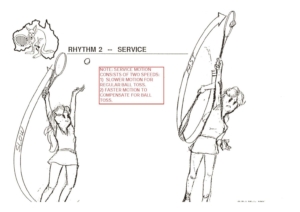
ServePlusOne Counter Strategy: Make Them Hit One More Ball
/in News, Singles, WhispererIn a previous blog, we explored the ServerPlusOne Strategy, emphasizing the importance of capitalizing on the first shot after the serve. But what’s the counter-play?
There’s an old adage in tennis: “Always make them hit one more ball than they’re comfortable with.” This principle is the cornerstone of effectively neutralizing the Serve +1 strategy. The goal is simple: get into the point and limit the server’s options for their +1 shot.
Make Court Geometry Your Friend: Deep Down the Middle
Use the court to your advantage by keeping your returns deep and central. Here’s how:
- Limit angles: A deep, central return cuts off the server’s ability to create sharp angles, forcing them to play safer, more predictable shots.
- Buy time: Depth pushes your opponent back, giving you crucial time to recover and prepare.
- Reduce errors: Aiming down the middle minimizes the risk of hitting wide or long.
Key Focus: Redirect the ball consistently deep into the back two-thirds of the court, prioritizing precision over power when under pressure.
Shot Selection Principles
The Serve +1 strategy thrives on early aggression. Your job is to disrupt it by staying composed and extending the rally:
- Neutralize, don’t attack: Focus on a controlled return to reset the point, rather than trying to overpower the server.
- Stay balanced: Ensure proper footwork and preparation to maintain stability during your shots.
- Recover quickly: After each shot, return to a strong central position, ready for the next ball. This forces the server to keep working to finish the point.
By applying these counter-strategies, you’ll not only neutralize the Serve +1 play but also turn defense into an opportunity to outlast your opponent.
The mantra here is clear: stay steady, stay deep, and keep them uncomfortable.
ServePlusOne Strategy
/in News, Singles, WhispererThe net is where matches are won!! So when is the best time to approach the net?
Let’s look at the cold, hard stats from singles play at the 2024 US Open:
Men:
- Baseline Win % = 47%
- Net Win % = 65%
Women:
- Baseline Win % = 48%
- Net Win % = 66%
The message is crystal clear—the net is your winning zone. But when’s the perfect time to attack?
The Ideal Moment to Approach the Net
The best time to make your move? It’s on the Serve +1 shot—that first ground stroke after your serve.
Here’s the winning play:
- Start with a quality serve. Aim to target your opponent’s weaker side or exploit their tendencies.
- Identify the short return. A well-placed serve often forces your opponent to cough up a short ball in front of your ghost line.
- Make your decision—and go for it. In these moments, you have a choice: stay back or attack. Always attack. Your net win percentage will thank you.
Why Commit to the Net?
In a 50-50 scenario, choosing to approach gives you the edge:
- Apply Pressure: Force your opponent into a difficult passing shot under stress.
- Take Control: At the net, you dictate the point with decisive volleys or crushing smashes.
- Front Foot: Moving forward means avoiding backpedaling to maintain your balance and positioning yourself more effectively for the next shot.
Tips for the Serve +1 Approach
- Hit a Quality Approach Shot: Go deep with pace, or use a low slice to force an awkward return
- Get Into Position: Move to a strong volley-ready stance, covering the middle while staying alert for passing shots
- Commit Fully: Hesitation is your enemy. Be bold and trust the odds to move forward.
The stats don’t lie, and the strategy is proven. Master the Serve +1 approach, and you’ll immediately elevate your game.
If you’re not making regular trips to the net, you’re missing a golden opportunity to dominate points and win more matches.
Choosing the Right Coach: A Parent’s Guide to Shopping for Tennis Pros
/in Ask the Pro, News-
Immediate Wins May Overshadow Development: Parents often gravitate towards programs or coaches that produce quick results, but the best coaches focus on the holistic development of the player—technique, mental resilience, and adaptability. It’s essential to recognize that long-term growth often outweighs short-term victories.
-
Longer-Term Success Matters More: Look for a coach who can help your child develop into a well-rounded player over the years, not just one who wins tournaments in the short term. The ability to sustain and nurture growth is key, and this is a crucial factor in ensuring long-term success in the sport.
-
Skill Diversification vs. One-Size-Fits-All: Tennis players, especially juniors, develop at varying rates. Coaches who tailor their approach—focusing on unique technical adjustments, mental toughness, or strategic thinking—are often more successful than those who adopt a one-size-fits-all method. It’s important that your child receives personalized training that aligns with their strengths and areas for improvement.
-
Resilience vs. Results: A coach’s role isn’t just to win matches; it’s to build resilience. A great coach prepares players to handle losses constructively, teaching them how to bounce back and use setbacks as opportunities to grow. Developing mental toughness and emotional stability is as important as improving technique.
- Does the coach emphasize skills like balance, footwork, and mental toughness, which provide long-term benefits?
- Can they articulate a plan for your child’s growth, not just for this season, but for the next several years?
- Are they focusing solely on winning now, or are they teaching adaptive strategies to handle varied opponents and court surfaces?
Application of Infrared (IR) Therapy to Tennis-Related Soft Tissue Injuries
/in News, Tennis4LifeMechanism of IR Therapy in Tissue Healing
-
Mitochondrial Activation:
- Infrared wavelengths, particularly in the near-infrared (600–1100 nm) spectrum, are absorbed by mitochondrial chromophores such as cytochrome c oxidase (CCO). This triggers enhanced ATP production and nitric oxide release, providing cells with increased energy to support tissue repair and healing.
-
Enhanced Circulation:
- Nitric oxide-induced vasodilation improves blood flow to the affected area, ensuring efficient delivery of oxygen and nutrients essential for recovery.
-
Reduction in Pain and Inflammation:
- IR therapy decreases inflammation by modulating reactive oxygen species (ROS) and activating cellular signaling pathways, alleviating the discomfort associated with acute or chronic tennis injuries.
-
Tissue Regeneration:
- Promotes collagen synthesis and stimulates stem cell activity, aiding in the regeneration of injured ligaments, tendons, and muscle tissue.
-
Deeper Penetration:
- IR wavelengths effectively penetrate deep into soft tissues, making it suitable for addressing both superficial and deep-seated injuries like tendinopathies or ligament damage.
Applications in Tennis Injury Management
-
Acute Injuries (Sprains, Strains):
- Applying IR therapy early can reduce swelling, alleviate pain, and create an environment conducive to rapid healing.
-
Chronic Overuse Injuries (e.g., Tennis Elbow, Tendonitis):
- Consistent use of IR therapy can enhance tendon repair by promoting collagen production and reducing chronic inflammation.
-
Post-Surgical Recovery:
- Following procedures such as rotator cuff or ligament repair, IR therapy accelerates healing, reduces scar tissue formation, and aids functional restoration.
-
Muscle Recovery Post-Match:
- Non-injured athletes can benefit from IR therapy to decrease muscle soreness and recover faster after intense matches or practice sessions.
Key Considerations for Effective Use
- Dosage and Parameters:
- Optimal results require the correct intensity and duration. IR wavelengths between 600–1100 nm and energy levels within therapeutic ranges (<100 mW/cm², fluence of 0.04–50 J/cm²) ensure safe and effective outcomes.
- Patient Preparation:
- Ensure the target area is clean and free of barriers like sweat, lotion, or clothing for maximum infrared penetration.
- Session Frequency:
- Regular application, typically several times a week, produces the best results. Chronic injuries may require extended treatment periods.
- Safety Precautions:
- Avoid excessive exposure to prevent potential overheating of tissues.
Integration with Tennis Training and Recovery
- Immediate Post-Injury Use:
- Integrate IR therapy into physiotherapy routines immediately following an injury for targeted tissue repair.
- Injury Prevention:
- Regular application to areas prone to overuse, such as the shoulders, elbows, and knees, helps prevent chronic conditions.
- Combined with Functional Training:
- Pair IR therapy with light exercises and balance drills to reinforce muscle coordination and prevent future injuries.
Guts & Glory: Nadal’s Battle with Injuries
/in News, Tennis4LifeHistory of Injuries:
-
Muller-Weiss Syndrome:
- Diagnosed at 18, this rare congenital condition affected the navicular bone in his left foot, causing pain and vulnerability to lower-body injuries. This condition defined his career challenges from beginning to end.
-
Ankle and Knee Issues:
- Stress fractures and patellar tendinitis in the early 2000s sidelined him, notably in 2004 and 2009. These injuries stemmed partly from the adjustments made for his foot condition.
-
Wrist and Shoulder Injuries:
- Persistent wrist injuries, including a torn tendon in 2016, and recurring shoulder pain impacted his ability to maintain consistency.
-
Hip and Abdominal Strains:
- Late in his career, hip and abdominal injuries became prominent, including during the 2023 Australian Open and the 2022 Wimbledon semifinal.
-
General Wear and Tear:
- Accumulated damage over two decades from his physical playing style, including significant strain on his back and joints.
Management and Adaptations:
-
Customized Footwear:
- Specialized shoes redistributed weight away from the damaged bone, enabling him to continue playing but also contributing to knee and back issues.
-
Selective Tournament Participation:
- Nadal often skipped hard-court seasons and reduced his schedule to focus on events that suited his strengths and minimized physical strain.
-
Advanced Rehabilitation:
- His team employed cutting-edge physiotherapy, strength training, and recovery techniques, including surgery when necessary.
-
Mental Fortitude:
- Nadal’s resilience and psychological strength allowed him to overcome injuries and remain competitive. This mindset was integral to his training and recovery.
-
Strategic Training:
- Focused on specific drills that minimized impact while maximizing performance, allowing him to adapt his game over time.
Winning Mindset: Djokovic’s Mental Edge
/in News, Psychology, WhispererNovak Djokovic’s psychological strategies that enhance his performance revolve around a strong mental foundation, leveraging psychological tools, and adopting adaptable mindsets. Key elements include:
- Using Fear as Motivation:
- Djokovic admits fearing failure—losing matches, disappointing himself, his coach, or fans. He reframes this fear as a driver for high-intensity preparation and performance.
- Observational Skills:
- He meticulously observes his opponents during breaks, assessing signs of physical strain such as sweating, breathing patterns, or other subtle cues for psychological advantage.
- Selective Hearing:
- In high-pressure matches, like the 2019 Wimbledon final against Federer, Djokovic mentally transforms the audience’s chants for his opponent into support for himself. This mental reframing boosts his confidence.
- Mindful Breathing:
- He emphasizes conscious breathing to regain focus and reduce stress. This mindfulness practice helps him remain present and manage pressure effectively.
- Balancing Training and Rest:
- Djokovic values stepping away from intense training when needed, using walks, family time, and reading to maintain balance and prevent burnout.
- Capitalizing on Experience:
- While acknowledging that physical attributes like speed may decline with age, he credits his experience and mental resilience for smarter play and better pressure management.
Djokovic’s mental strategies showcase the critical role of mindset, preparation, and adaptability in sustaining peak performance over time.

Credit SI : Andrew DeGraff
Source: Sports Illustrated
Elevating Your Doubles Game
/in Doubles, News, WhispererIn tennis, doubles is the game for most players—it’s fast-paced, strategic, and requires teamwork in a way singles never will. Mastering doubles means understanding how to control the court, support your partner, and capitalize on each shot. Here’s a quick guide to some essential doubles strategies to help you dominate the court, improve synergy with your partner, and play smarter. Whether you’re a beginner or seasoned player, these tips will sharpen your doubles play and set you up for success!
1. Manage Your Court Real Estate:
Apply the 80% Rule: around 80% of shots land in the “Magic Diamond” near the center of the service box. Prioritize defending this area, particularly when moving to protect the middle. Even if you can’t reach every shot, positioning yourself toward the center increases your chances to make effective plays.
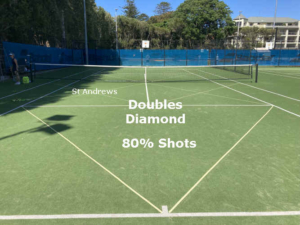
2. Embrace the Team Element:
Doubles is all about collaboration. Often, one player can position themselves for the winning shot without touching the ball! The server and receiver should focus on setting up their partner at the net, where winning points becomes easier. The net is where the magic happens! And the Saint Andrews Cross position is a great way to add some spice to your doubles play and really keep your opponents on their toes. Plus, it’s a whole lot of fun!
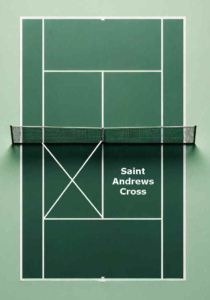
3. Be a Threat at the Net:
Assert yourself as a force at the net to pressure your opponents. Whether you’re a “blitzkrieg” type like our German friend Thomas, dominating with a powerful presence, or a quick mover like Tim, always aim to disrupt and provoke errors from the opposition with your positioning and movement.
4. Prioritize Your First Serve:
Aim for an 80% first-serve success rate by dialing back on power if needed. This approach gives you more control over the point, increases your chances to position for volleys, and helps your partner to be in an optimal spot for a winning play—a win-win-win! A solid first serve also keeps opponents on edge, giving you the upper hand.
Rafa’s Slice Return: A Masterclass in Neutralizing Big Servers
/in News, WhispererWhy Nadal’s Slice Return Works Against Big Servers
-
Disrupting Rhythm: Against players whose games rely heavily on dominating with the serve, the slice return interrupts their timing. By delivering a slower, spinning ball, Nadal breaks the rhythm that these players rely on to dictate points.
-
Depth and Placement: Nadal’s slice return isn’t just defensive; it’s designed to land deep in the court, often targeting the server’s weaker wing or forcing them into awkward positioning. This limits the server’s ability to step forward and attack.
-
Turning Defense into Neutral: While many players treat big serves as purely defensive scenarios, Nadal’s slice return neutralizes the advantage, flipping the point into a baseline rally where he excels.
-
Consistency Under Pressure: Big servers count on quick, decisive points, but Nadal’s relentless consistency and precise slice return force them to engage in extended rallies, which are rarely their forte.
Key Elements of Nadal’s Slice Return
- Early Preparation: Nadal reads serves early, using his athleticism and footwork to position himself optimally.
- Heavy Backspin: His slice return features significant spin, ensuring the ball stays low and slows down after the bounce.
- High Trajectory: The added height and depth allow the ball to arc safely over the net while still landing deep, denying the opponent an easy approach shot.
- Defensive Precision: Nadal uses the slice return to nullify the first-strike potential of big servers, drawing them into longer rallies.

Source: ATP
Rafael Nadal: A Legendary Career of Tenacity and Triumph
/in News, Whisperer“He makes you suffer. First he takes your legs, then your mind.”
While Rafael Nadal will forever be celebrated as the ‘King of Clay,’ his legacy transcends the court as a fierce competitor, an innovator, an ambassador for tennis, and a passionate champion of the sport!

Source: ATP
Mastering the Mental Game: Navigating Turning Points in Competitive Tennis
/in News, Psychology, Tournaments, WhispererIn tennis, we often hear about “momentum” – those stretches when everything just clicks, or conversely, when things feel like they’re slipping away.
Understanding and mastering these psychological dynamics can be the key to turning matches around, and even more importantly, sustaining your best performance under pressure.
What is Momentum and Why Does it Matter?
In the world of competitive sports, momentum is the intangible force that athletes feel during moments when everything is either going right (positive momentum) or everything seems to go wrong (negative momentum).
In tennis, this often happens around critical moments known as “turning points” – those situations that can shift a player’s sense of control in a match, either driving them to a new high or shaking their confidence.
Turning points aren’t just about the score. They could be winning a risky point when you’re down, or missing a relatively easy shot at a key moment. Your response to these moments can be pivotal.
Insights from Elite Players
To dig deeper into the psychology of turning points, researchers interviewed nine elite tennis players from various countries who have played in Grand Slam events and represented their countries. By examining their experiences and strategies, the study revealed a few key themes around how top players approach these critical moments:
Positive Turning Points:
– Players described moments that directly impact the score, like winning a high-stakes point through a risky play. But it’s not all about scoring; psychological wins matter too, such as building confidence through steady focus or overcoming pressure on tough points.
Negative Turning Points:
– Mistakes at crucial junctures can lead to feelings of lost control. Players described these moments as spirals that can either shake confidence or prompt a surge of focus, depending on their reaction.
Building a Strong Response: Strategies to Shift Momentum
To navigate these turning points, elite players apply specific mental strategies that help them stay grounded, focused, and in control – especially when things get tense.
– Capitalizing on Positive Turning Points: Players build on successful moments to maintain momentum by focusing on their strengths and visualizing their success carrying forward. When things go right, they aim to sustain that energy by staying relaxed, confident, and in the moment.
– Coping with Negative Turning Points: Resilience is crucial. After a mistake, elite players don’t dwell on what went wrong. Instead, they use mental cues to reset, such as focusing on breathing, simplifying their game plan, or repeating a positive phrase. This helps them release frustration and regain control for the next point.
Takeaway for Competitive Players
Understanding and managing turning points is about more than just strategy; it’s about resilience and self-awareness. By incorporating these approaches into your practice and matches, you can train yourself to respond effectively to both high and low moments, giving you a competitive edge:
– Recognize Turning Points: Become aware of the moments that impact your sense of control, whether it’s a great rally win or a missed shot.
– Use Positive Momentum: When things go right, capitalize on it. Keep your focus forward and don’t get overly excited – aim for calm confidence.
– Respond to Negative Moments with Resilience: Acknowledge the setback, but don’t dwell. Use deep breaths, reset with a clear mental cue, and approach the next point with renewed focus.
Incorporating these psychological strategies can help you turn potential weaknesses into strengths, no matter what happens on the court. And remember, the mental game is as important as your physical skills – make it part of your training, and watch your performance improve.
Source: The psychology of turning points in tennis
Ana Soares (POR) and Chris Harwood (GBR)
ITF Coaching and Sport Science Review 2017; 71 (25): 26 -27
Jannik Sinner: From Tennis Prodigy to Italy’s National Hero
/in News, WhispererMastering the ABCs of Doubles Play
/in Ask the Pro, News, WhispererIn doubles tennis, mastering the fundamentals of net play is essential to gaining a competitive edge. Playing the net effectively involves more than quick reflexes; it requires strategic awareness and precise movements that keep you engaged and positioned to impact the point.
Known as the ABCs of doubles play, there are three core principles — where you look, how you respond to your partner’s shots, and how you get out of harm’s way — provide a solid foundation for any player looking to improve their doubles game.
Below, we delve into each principal in detail, illustrating how these techniques can help you win more points, avoid common errors, and enhance your overall enjoyment on court.
The ABCs of Playing Doubles
A. Where You Look: While at the net, always keep your focus forward. When the ball is in your partner’s court, avoid the temptation to look back at them. Instead, concentrate on watching the opposing net player, as this allows you to anticipate any interception attempts or poaches they might make. When the ball is in the opponents’ court, shift your focus to the player hitting the ball, usually the back player. This continual scanning helps you stay engaged and be ready to play.
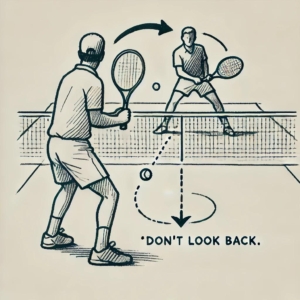
B. How You Respond to Your Partner’s Shots: Your positioning and readiness at the net should be influenced by your partner’s shots. For instance, when your partner hits a shot that may be intercepted, you need to prepare to defend against an immediate return. This often involves either stepping forward to challenge the shot or stepping back to give yourself reaction time. Reading the opponent’s net player’s body language can give clues on their intent, allowing you to adjust your position proactively.
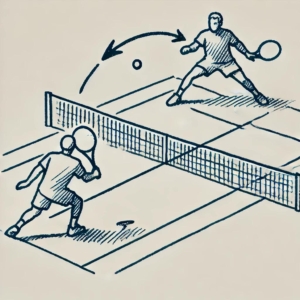
C. How You Get Out of Harm’s Way: In doubles, standing at the net can put you in the line of fire. If the opposing net player is about to hit a hard shot directly toward you, it’s crucial to get out of the way safely. Instead of backpedaling, which is less stable, practice a quick side step toward the sideline. This pivot not only keeps you safe but also helps you concede the point with minimal risk of injury if the shot is unavoidable.
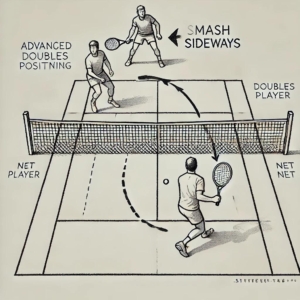
These essential principles enhance both your effectiveness and safety at the net, maximizing your ability to contribute to each point without unnecessary risk.

Recent News
- Pro Tennis Under the Spotlight
- How Long Does It Take to Get Fit Again?
- Burnout & Growing Professionalization of Youth Tennis
- The Nocebo Effect
- Forensics of Lobbing
- Injury, Mental Health, and the Tennis Doom Loop
- Tournament Fatigue at Manly Seaside Championships
- When the Achilles Tendon Snaps
- Next Gen: Maya Joint
- Manly Seaside Men’s Final Recap




